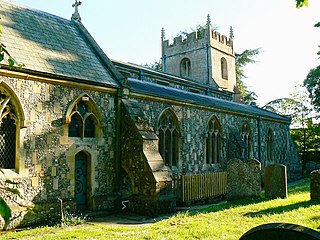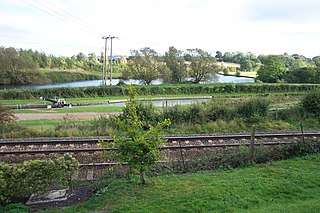
The Wilton Windmill is a five-floor brick tower mill, standing on a chalk ridge between the villages of Wilton and Great Bedwyn in the southern English county of Wiltshire.

The Wilton Windmill is a five-floor brick tower mill, standing on a chalk ridge between the villages of Wilton and Great Bedwyn in the southern English county of Wiltshire.
The mill was built in 1821 because the construction of the Kennet and Avon Canal had included the canalisation of the River Bedwyn which had previously powered several water mills in the area.
The windmill was in use for a century, continuing into the 1920s, but fell into disuse, probably as the result of competition from large steam roller mills. In the 1960s it was added to the list of buildings of architectural or historical merit as Grade II*. [1] In 1971 it was bought by Wiltshire County Council and leased to the Wiltshire Historic Buildings Trust, which early in 1972 began to restore it to working condition. [2] By the end of the summer of 1976 the windmill was once again making flour.
It is now owned by Wiltshire Council and managed by the Wilton Windmill Society, formed in 1976 and operated entirely by volunteers. [2] In the 1980s the mill was in financial difficulties, which led to the Society forming a cricket XI, the Wilton Millers' Cricket Team, to raise funds by playing sponsored matches, and in 2011 this was still in existence, although no longer needed for fundraising. [2]
Flour, made from locally grown wheat, is still produced at the mill and can be bought on site and in local shops. [2]

As when it was first constructed, the mill has a fantail, which causes the cap bearing the sails to turn to make best use of the available wind. Of the four sails, two are of canvas and two are more complicated "patent sails", each consisting of twenty-two sections which can be angled. [2]
Position: grid reference SU275616
Nearby towns and cities: Hungerford, Marlborough, Newbury, Swindon
Nearby villages: Wilton, East Grafton, Great Bedwyn, Burbage, Shalbourne, Pewsey
Nearby places of interest: Crofton Pumping Station, Kennet and Avon Canal, Wilton Water, Pewsey White Horse
Wilton Windmill featured in an episode of Victorian Farm Christmas , first aired on BBC Two on 11 December 2009. [3] It also appeared in the short film Jerusalem starring pop group The Style Council, filmed in 1986 for a direct to video release in 1987; in the film the band performs the song Heaven's Above at the windmill.

Wiltshire is a historic and ceremonial county in South West England with an area of 3,485 km2. It is landlocked and borders the counties of Dorset to the southwest, Somerset to the west, Hampshire to the southeast, Gloucestershire to the north, Oxfordshire to the northeast and Berkshire to the east. The county town was originally Wilton, after which the county is named, but Wiltshire Council is now based in the county town of Trowbridge. Within the county's boundary are two unitary authority areas, Wiltshire and Swindon, governed respectively by Wiltshire Council and Swindon Borough Council.

The Kennet and Avon Canal is a waterway in southern England with an overall length of 87 miles (140 km), made up of two lengths of navigable river linked by a canal. The name is used to refer to the entire length of the navigation rather than solely to the central canal section. From Bristol to Bath the waterway follows the natural course of the River Avon before the canal links it to the River Kennet at Newbury, and from there to Reading on the River Thames. In all, the waterway incorporates 105 locks.

The Vale of Pewsey or Pewsey Vale is an area of Wiltshire, England to the east of Devizes and south of Marlborough, centred on the village of Pewsey.

Pewsey is a large village and civil parish at the centre of the Vale of Pewsey in Wiltshire, about 6 miles (10 km) south of Marlborough and 71 miles (114 km) west of London. It is within reach of the M4 motorway and the A303 and is served by Pewsey railway station on the Reading to Taunton line.

Crofton Pumping Station, near the village of Great Bedwyn in Wiltshire, England, supplies the summit pound of the Kennet and Avon Canal with water.

Great Bedwyn is a village and civil parish in east Wiltshire, England. The village is on the River Dun about 4.5 miles (7.2 km) southwest of Hungerford, 14 miles (23 km) southeast of Swindon and 6 miles (9.7 km) southeast of Marlborough.

Alton is a civil parish in Wiltshire, England. The parish includes the adjacent villages of Alton Barnes and Alton Priors, and the nearby hamlet of Honeystreet on the Kennet and Avon Canal. It lies in the Vale of Pewsey about 6 miles (10 km) east of Devizes.

Burbage is a village and civil parish in the Vale of Pewsey, Wiltshire, England. It is about 6 miles (9.7 km) south of Marlborough and 20 miles (32 km) west of Newbury.

Grafton is a civil parish in Wiltshire, England, in the Vale of Pewsey about 7 miles (11 km) southeast of Marlborough. Its main settlement is the village of East Grafton, on the A338 Burbage - Hungerford road; the parish includes the village of Wilton and the hamlets of West Grafton, Marten and Wexcombe.

The River Dun is a tributary of the River Kennet, flowing through Wiltshire and Berkshire in England. Its main source is in the parish of Great Bedwyn, Wiltshire and it flows 16 kilometres (10 mi) in a northeasterly direction into Berkshire. It discharges into the Kennet at Hungerford, which has a smaller average flow and width upstream of that point.

Limpley Stoke is a village and civil parish in Wiltshire, England. It lies in the Avon valley between Bath and Freshford, and is both above and below the A36 road.

Burnt Mill Lock is on the Kennet and Avon Canal, at Great Bedwyn, Wiltshire, England.

Crofton Locks are a flight of locks on the Kennet and Avon Canal, near the village of Great Bedwyn, Wiltshire, England.

Wilton Water is a small reservoir, southwest of the village of Great Bedwyn in the English county of Wiltshire, which supplies the summit pound of the Kennet and Avon Canal with water. The reservoir lies in the parish of Grafton and collects rainfall from the eastern end of the Vale of Pewsey and the surrounding hills.

Milton Lilbourne is a village and civil parish in the county of Wiltshire, England, in the Vale of Pewsey between Pewsey and Burbage. It is largely a mixed residential area centred on the Manor. The nearest town is Marlborough, 5.5 miles (8.9 km) to the north.

Victorian Farm is a British historical documentary TV series in six parts, first shown on BBC Two in January 2009, and followed by three Christmas-themed parts in December of the same year. The series, the second in the BBC historic farm series, recreates everyday life on a farm in Shropshire in the 1880s, using authentic replica equipment and clothing, original recipes and reconstructed building techniques. It was made for the BBC by independent production company Lion Television and filmed at a preserved Victorian era living museum farm, Acton Scott Historic Working Farm, Shropshire. The farming team was historian Ruth Goodman, and archaeologists Alex Langlands and Peter Ginn.

Stanton St Bernard is a village and civil parish in the Vale of Pewsey, Wiltshire, England. Its nearest town is Devizes, about 6 miles (10 km) away to the west.

Wilcot is a village in Wiltshire, England, in the Vale of Pewsey about 6 miles (10 km) southwest of Marlborough and 1.5 mi (2.4 km) northwest of Pewsey.

Savernake is a civil parish immediately south and southeast of Marlborough in Wiltshire, England. The settlements in the parish are the hamlets of Cadley,Clench Common and Forest Hill. Savernake Forest covers the eastern half of the parish.